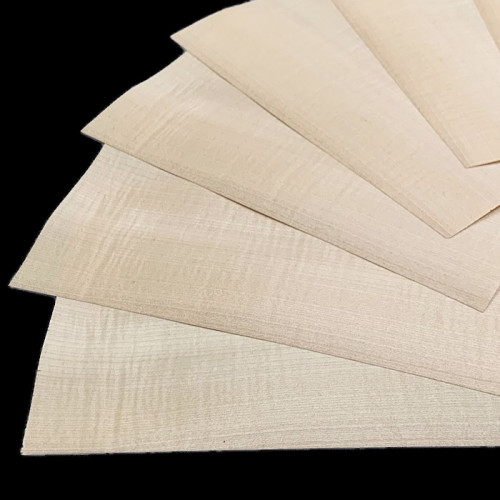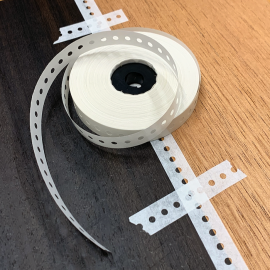
Shadow Figure Sycamore 0.3 mm small-size veneer
Shadow Figure Sycamore 0.3 mm small-size veneers
Genuine wood sliced-veneer sheets.
Selected single veneers, no sequence.
Fix length of 30 cm.
Width: From 15 to 21 cm, depending on availability.
Thickness: 0.3 mm.
Sold by the sheet.
Warning: Please read carefully the description below.
Shadow Figure Sycamore 0.3 mm small-size veneer
Genuine wood sliced-veneer sheets.
Selected single veneers, no sequence.
Warning:
0.3 mm is half the thickness of the standard 0.6 mm.
This thickness is ideal for creating complex wraps or using its translucency to produce lampshades.
Dimensions:
Fix length of 30 cm.
Width: From 15 to 21 cm, depending on availability.
Thickness: 0.3 mm.
Sold by the sheet.
Measurement scaling:
The width is rounded to the covered centimeter, for example, 15.8 cm, giving 15 cm.
Photos:
To keep the cost of these products as low as possible, unlike other veneers on this website, the pictures of small-size veneers do not represent the available stock.
What are Small-size Veneers?
These are veneer sheets with a fixed length of 30 cm (exactly 30.5 cm).
These sheets are not in a continuous sequence and may come from different logs.
What are Sycamore veneers?
What are the common names of Sycamore?
Sycamore, European maple, sycamore maple.
What is the botanical name of Sycamore?
Acer pseudoplatanus.
What is the origin of Sycamore?
The sycamore maple is the European maple found throughout Europe, North Africa, and Western Asia. It is one of the most common trees in Europe.
How do you recognize Sycamore?
Sycamore is a hardwood called "white" but with a slightly ivory tone. Unlike its North American cousin, the sugar maple, it does not have "sugar hair." However, sycamore has small wood-colored pinknots; these pinknots are inevitable, and a sycamore without pinknots is extremely rare.
This forest species is one of the semi-precious hardwoods, but in its figured form (rare, accounting for less than 1% of forest production), it becomes a precious wood.
Sycamore is called "plain" when it is not figured. However, plain sycamore can occasionally have flames and shadow figures, which are very light figures that are not marked enough to be considered figured wood.
What are Shadow figures?
Shadow figures are faint light figures, barely visible or visible at a specific angle of light. A veneer with a shadow figure is not figured enough to be considered a figured veneer and too figured to be considered a smooth veneer.
Long considered the "ugly duckling," shadow figure veneers are now highly appreciated for their pearly touch. They are less eye-catching than traditional figured veneers but more vibrant than a plain veneer.
Shadow figure veneers are often found in sycamore wood. They are prized for their unique and subtle appearance, which can add a touch of sophistication to any piece of furniture or décor.
What are the mechanical properties of Sycamore?
Weight: 615 to 650 Kg / m3, average weight at 10 - 12% humidity.
Janka hardness: 4680 Newton. For comparison, Oak is 4980 N, and Poplar is 1650 N.
Elasticity: 9.92 GigaPascal, for comparison: Ash 12.31 GPa and Poplar 9.75 GPa.
Flexural Strength: 55 Megapascals (for comparison: US Maple is 109 MPa, and Yew is 96 MPa)
What are the uses of Sycamore?
Its natural beauty and strength make it a popular wood for furniture manufacturers, stairs, parquet floors, and paneling.
In instrument making, Luthiers particularly appreciate the veneers of Fiddleback Sycamore for their warm sound, especially for making violins, cellos, and double basses.
In decoration, its light color and fine grain blend perfectly with various interior styles, adding a touch of elegance and modernity.
How to use veneers?
How to cut the veneers?
Veneers can be easily cut with a utility knife.
For straight cuts, the best results are obtained with a veneer saw.
Use a fretsaw, scalpel, or veneer knife for curved cuts.
Always allow for a slightly larger veneer sheet than your intended surface. This will allow you to adjust the size after gluing for a clean finish.
A flush trimmer can also be used to trim the veneer after it has been glued.
When cutting with a utility knife or a veneer knife, it's best to cut with the grain of the wood. To check this, run your finger along the edge of the sheet. The direction that feels smoothest is the ideal direction for cutting.
What is veneer splicing?
Since veneers come in the width that nature gave us, you may need to cover an area wider than the available veneers.
Therefore, you need to splice the veneers by gluing or fixing them side by side with tape to obtain the desired width.
Trim the veneer's edges with a straight, smooth cut to achieve a good joint.
Stick the veneers in place with tape (the blue one is a good choice).
Usually, the veneers are spliced side by side, but they can also be spliced foot by foot to obtain a longer length.
The splicing must be done before gluing the veneers on the substrate.
What Glue to Use for Veneering?
Several types of gluing are possible.
Vinylic glue (PVA or PVB) is well-suited for porous substrates such as plywood, particleboard, or MDF. The veneers must be pressed with clamps over the entire surface at once.
Note: Veneers can also be glued using vinyl glue and an iron, but we strongly recommend this technique only if other gluing solutions are not possible.
- Neoprene glue is applied to all surfaces, especially non-porous surfaces, using two coats of glue and marouflage.
- Animal glue, such as hide, sinew, or bone glue, is a product that must be cooked in a double boiler and used hot.
How to Sand Veneers?
Veneers and all our products are genuine wood and can be sanded according to the thickness of the veneer.
Please do not use a belt sander, regardless of the veneer's thickness, as it could pierce it.
With a 0.6 mm veneer, lightly sand with 120 grit and then finish with 180 or 240 grit. With an orbital sander, 180 grit is already sufficient for most applications.
For 0.3 mm veneers, sanding is a particularly delicate operation. It is recommended to sand by hand with the finest possible abrasive; personally, I use the green side of kitchen sponges.
How to Finish a Veneer Realization?
All finishing products generally used for wood are suitable for finishing our products. For example, you can use a varnish, wax, paint, or oil.
However, ensure that the product you want to use is compatible with the final use of your creation.
More information:
Please look at our TUTORIALS; you might find some valuable tips.
Please contact us by email or phone for any additional information.
Data sheet
- Species
- Sycamore
- Thickness group
- Thin thickness
- Width group
- Standard width
- Grade
- Fiddled back
You might also like
 English
English








